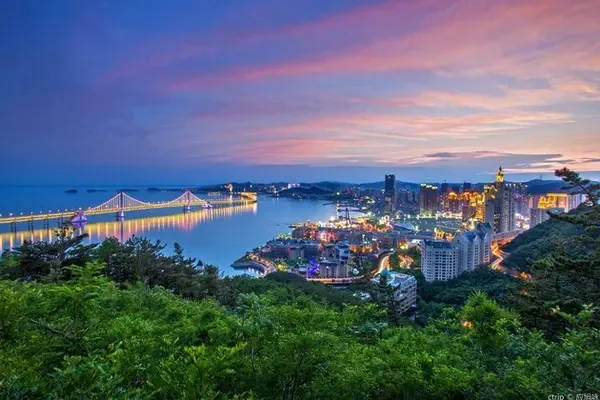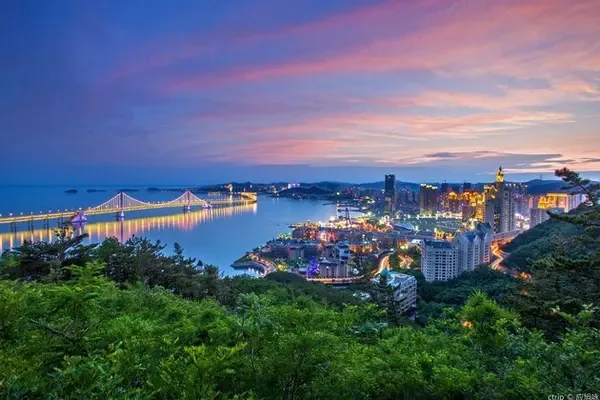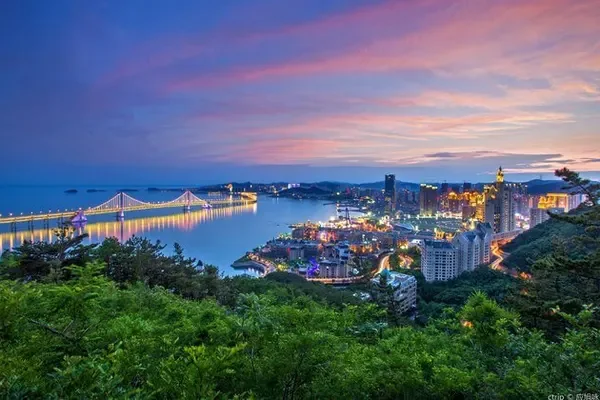Zhengding County, an unusual small county located in the North China Plain; a county under the jurisdiction of Shijiazhuang, one of the country's most non-existent provincial capitals.
Zhengding was called Changshan and Zhending in ancient times, which was taken from the meaning of "true stability". In history, it was once called "the three northern towns" together with Beijing and Baoding. As a famous national historical and cultural city, although it is only a small county, there are many cultural relics, which can be compared with the Internet celebrity cities Xi'an and Nanjing, and it is not inferior!
Zhengding County is located in the southwest of Hebei Province, bordered by the Hutuo River in the south of the city and the urban area, in the middle of the endless North China Plain.
Zhengding has been the political, military and cultural center of the Central Plains since ancient times. In the eleventh year of Emperor Gaozu of the Han Dynasty (196 BC), Dongyuan County was changed to Zhending County, which belonged to Hengshan County. In the first year of Qianyuan (179 BC) of Emperor Wen of the Han Dynasty, to avoid the taboo of Emperor Wen Liu Heng, Hengshan County was changed to Changshan County. This is Zhengding's "Three Mountains Not Seen": Hengshan, Changshan, and Zhongshan all have the word "mountain", but not "mountain". Among them, the earliest sources of two mountains.
The general appearance of Zhengding City is basically a square city building, and the southeast corner is missing. The Wai Guo is in the shape of an "official hat", which means "the sky is full in the northwest and the ground is lacking in the southeast". The northwest is full and the southeast is slightly lacking. There are four gates in the east, west, south and north. The east gate is named Yingxu, the west gate is named Zhenyuan; the south gate is named Changle; the north gate is named Yong'an.
Zhengding's Wengcheng is much larger than the old cities of Xi'an and Nanjing, which shows its important military status. In the city, government offices, military camps, Confucian temples, Taoist temples, Chenghuang temples, and temples are scattered in scattered distribution. "Huahua Zhending Mansion, Splendid Taiyuan City" is evidence of the prosperity of Zhengding. In the Yuan Dynasty, a large number of Persians followed the Mongolian army and came to Zhengding City to engage in politics, do business, preach, and settle down. It even attracted the attention of Marco Polo, an Italian who traveled to China. Due to the change of times, most of the buildings can not be found, but there are still many cultural relics, especially the four towering pagodas, which can be said to be a great miracle.
In the first year of Shunzhi in Qing Dynasty (1644), it belonged to Zhili Province. In the first year of Yongzheng (1723), Zhending Mansion was changed to Zhengding Mansion because of avoiding the taboo of Shizong Yinzhen, which governed one state and thirteen counties including Zhengding. This is the earliest name of "Zhengding".
As the saying goes, "small people come out of a big place, and big people come out of a small place". Zhengding is rich in natural treasures, outstanding people, and celebrities have emerged in large numbers since ancient times. The "hundred-year-old emperor" Zhao Tuo, the ever-victorious general Zhao Yun, the famous minister Liang Gelao, and the Dragon King Shizhen from Beiyang.
It is said that Zhao Tuo lived to be 103 years old. Because he was once the king of the famous "Nanyue Kingdom" in Chinese history, later generations called him a hundred-year-old emperor. Chairman Mao once spoke highly of him as "the first cadre going south" in Chinese history.
The victorious generals Zhao Yun and Zhao Zilong must be well-known to everyone, so there is no need to say more. There is Zhao Yun Temple in the northeast gate of Zhengding.
Liang Gelao, a famous minister of a generation, Liang Menglong (1527-1602), styled Ganji, was born in Zhending, Beizhili, and is now from Beishengban Village, Zhengding County. A politician and military strategist in the Ming Dynasty, from officials to the Minister of the Ministry of War, the Minister of the Ministry of Officials, and the Prince and Taibao. History books appraised him as an upright official and outstanding military exploits, and he received a series of awards such as being promoted to a noble rank by Emperor Wanli. Liang Ge Lao is a famous person who has been passed down in Ming history and praised by the common people. He is known as "Liang Ge Lao". He is the author of "History Yaobian" and "New Research on Shipping". So far, there are still Liang's Ancestral Hall and Jiaolin Bookstore in the middle of the historical and cultural district in Zhengding City.
Wang Shizhen (1861-1930), a well-known modern figure in Zhengding, was born in Niujiazhuang, Nanniu Township, with the style name Pingqing. The head of the Beiyang Three Heroes (Wang Shizhen, Duan Qirui and Feng Guozhang are known as the "Beiyang Three Heroes-Dragon, Tiger, and Dog"). In that war-torn era, in order to protect the common people from the flames of war, Wang Shizhen had repeatedly mediated the disputes between Zhiwan and other warlords, minimizing the loss of the people.
Wang Shizhen's former residence is located on Zhongshan West Road in the west gate of the county seat, across the street from the Wang's Shuangjie Temple built in memory of the two mothers. Built in 1912, it has a history of more than 100 years. It is a typical courtyard building. The original east, middle and west three roads, covering a total area of about 10,000 square meters, now only the middle road remains, which is a courtyard with two entrances. As soon as you enter the courtyard, there were originally two wisterias, which were transplanted here by the German minister from India, and now only one wisteria is left on the west side. This is a gift from the German Minister to Wang Shizhen after the completion of the compound. After 1949, historian Fan Wenlan came to North China Anti-Japanese University to work, lived here and wrote many historical works. Afterwards, it was successively used as the office of Zhengding county party committee organs and public security organs. It was listed as a key cultural relic protection unit at the county level in 1982, and it will be opened to the outside world at the end of 2020.
Zhengding County has 2 national intangible cultural heritage items, Changshan War Drum and Zhengding Gaozhao (Zhongfan). The Changshan Drum Troupe performed in accordance with the drum formation of Zhao Yun during the Three Kingdoms period, and participated in many national competitions and won awards.
As a national historical and cultural city, Zhengding has profound natural and cultural heritage and numerous cultural relics and historic sites. There are 38 existing buildings since the Sui and Tang Dynasties, and the national-level cultural relics rank second among county-level administrative regions in the country.
Inside the east gate of Zhengding City, there is a thousand-year-old temple - Longxing Temple, which is called "the first famous temple outside Beijing" by Mr. Liang Sicheng. Because of the tall copper-cast Avalokitesvara with thousands of hands and eyes in the temple, the local people commonly call it the Big Buddha Temple.
Longxing Temple, formerly known as "Longzang Temple". It was built in the sixth year of Emperor Kaihuang (586) of the Sui Dynasty. It was Yang Jian, who was called the most powerful emperor in China by the West. The Longzang Temple Stele is known as the "No. 1 Sui Stele".
Until the founding emperor of the Song Dynasty, Song Taizu Zhao Kuangyin ordered to cast bronze Buddha in the temple, Avalokitesvara with thousands of hands and eyes, and the Great Compassion Pavilion. A group of Song Dynasty buildings with the Great Compassion Pavilion as the main body began to be built. The Avalokitesvara with Thousand Hands and Thousand Eyes is the best in the world, the Mani Hall is an isolated example of ancient architecture in the world, and the octagonal Book Collection Pavilion is the oldest surviving collection of runners.
During the Kangxi and Qianlong years of the Qing Dynasty, there were two large-scale repairs and additions, and the temple developed to its heyday. In the forty-eighth year of Kangxi in the Qing Dynasty (1709), in order to maintain the imperial power forever, Emperor Kangxi ordered to change Longzang Temple to Longxing Temple, and built a palace on the west side of the temple. The two emperors Kangxi and Qianlong stopped here many times on their southern tours.
Every temple must have a pagoda. In addition to the large-scale Longxing Temple in Zhengding, there are also the "Four Pagodas in Zhengding" that have been preserved to this day. Duobao Pagoda. The four pagodas are exquisitely built and each has its own characteristics.
Chengling Pagoda of Linji Temple is located on the southeast side of Yanghe Building, inside Linji Temple, commonly known as Qingta, and is a national key cultural relics protection unit. Linji Temple is the ancestral court of the Linji Sect, and Chengling Pagoda is a Jin Dynasty building, which is a solid brick pagoda with octagonal nine levels and dense eaves. Chengling Pagoda is not only a historical witness of the friendship between the Chinese and Japanese people, but also a link to promote the friendship between the Chinese and Japanese people from generation to generation.
The Lingxiao Pagoda of Tianning Temple was built in the Tang Dynasty. The tower has nine floors, and the fourth to ninth floors are wooden structures. The biggest feature is the use of the tower core column structure, which is very beneficial to the stability of the tower body. Mr. Luo Zhewen, a famous expert on ancient architecture, said: "This kind of tower core column structure, "only the wooden pagoda of Tianning Temple in Zhengding, Hebei Province still has this structure. Form is the most precious instance".
The Duobao Pagoda of Guanghui Temple is commonly known as the Flower Pagoda by the locals. This is a pagoda of exotic style, located on the southeast side of the historical and cultural district, on the north side of Changle Gate, the south city gate. According to "Zhengding County Chronicles" in the first year of Guangxu, the temple was first built in the first year of Zhenyuan (785-805) of Emperor Dezong of Tang Dynasty, and was repaired in the middle of Ming Dynasty. In the late Qing Dynasty, the temple was destroyed, but only the pagoda remained. According to the structural form of the tower and the ink marks on the inner wall of the first floor in the sixth year of Zhenglong (1161), it is inferred that the tower should be a relic of the Liao and Jin Dynasties.
This pagoda has a unique shape and structure, which is different from our common pagodas. It is an isolated case in China and rare in the world. The plane of the first floor of the pagoda is octagonal, and the four fronts are additionally flattened and hexagonal pavilion-shaped single-story suite multi-pagoda. The body of the pagoda is tapered, and there are colorful sculptures of tigers, leopards, lions, dragons and Buddha statues in relief around the body. It is a miracle that the pagoda has survived nearly 1300 years of wind and rain, and the dynasty has changed. In 1961, it was listed as a national key cultural relic protection unit by the State Council.
Xumi Pagoda of Kaiyuan Temple, also known as the Wild Goose Pagoda, was built earlier than the Big Wild Goose Pagoda in Xi'an, and is located on the north side of the Historical and Cultural Street. It was first built in the second year of Xinghe in the Eastern Wei Dynasty (540). In the late Qing Dynasty, it fell into disrepair for a long time, the temples were destroyed, the halls collapsed, and only the bell tower and the Sumeru Pagoda remained. The existing buildings are in the Tang Dynasty style. Different from the layout of other temples, Kaiyuan Temple does not adopt the ancient Chinese architectural conventions, the symmetrical layout of the central axis style, but the tower and the bell tower stand side by side, which truly presents the development of Buddhist temple architecture from the early tower-centered to the late hall-centered transitional situation.
The plane of the tower is square, with nine levels of dense eaves. The lower part of the tower is built with stone slabs for a week, and a powerful statue of a strong man is embossed at both ends of each side. The upper end of the lintel is inlaid with a rectangular stone plaque, on which are engraved the four characters of "Xumi Qiaoli" in regular script. The bell tower of Kaiyuan Temple is the only existing Tang Dynasty bell tower in China.
Zhengding, as a low-key small city with many historical relics, is moving steadily towards a small and beautiful leisure city at a unique pace during the period of explosive development of this Internet celebrity city.



